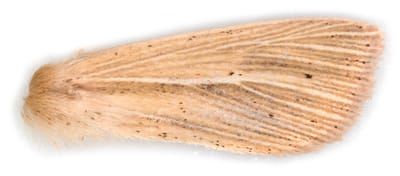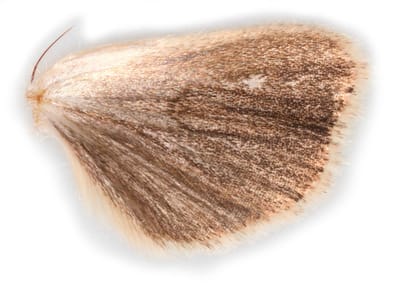73.293 Mythimna (Mythimna) impura (Smoky Wainscot)
ws: 31-38mm (MBGBI9.1), fw: 14-18mm (Waring & Townsend); Jun-Aug, occasionally bivoltine in south Sep-Oct; various grasses (Poaceae); common throughout GB.
ID: M.impura and M.straminea (Southern Wainscot) can be very similar to M.pallens (Common Wainscot), but they have a different forewing shape - in M.pallens the forewing base is narrower and the termen makes a steeper angle with costa; M.straminea has a straighter costa and a more pointed apex than M.pallens or M.impura.
M.impura has a straw forewing ground colour; the central vein is white-marked and bordered on its dorsal side with a blackish streak of variable intensity; there may be additional fine black interneural streaks in the terminal part of the forewing; hindwing smoky grey, but sometimes only lightly dusted with grey. Doubtful specimens can be identified by viewing the underside of the forewing which is extensively dusted with blackish scales in M.impura and largely white in M.pallens and M.straminea.
The forewing markings of M.impura can also be similar to Leucania comma (Shoulder-striped Wainscot) though the basal streak is not as strong and the distal margin of the discal cell is not white-lined in M.impura (the short part of the 'L' of M.l-album).
M.straminea has a whitish or greyish-straw forewing ground colour; a diffuse brownish streak runs along the dorsal margin of the central vein; variable dotted postmedian line; hindwing whitish with veins dark-lined and a dark dashed median line (which may be faint). Both M.impura and M.straminea show a dark central spot on the hindwing underside which is usually not present in M.pallens. Having said all that, I usually find the easiest way to recognise M.straminea is by looking at it head-on when it appears to be wearing a headband - due to narrow dark lines across the patagia.
M.impura has a straw forewing ground colour; the central vein is white-marked and bordered on its dorsal side with a blackish streak of variable intensity; there may be additional fine black interneural streaks in the terminal part of the forewing; hindwing smoky grey, but sometimes only lightly dusted with grey. Doubtful specimens can be identified by viewing the underside of the forewing which is extensively dusted with blackish scales in M.impura and largely white in M.pallens and M.straminea.
The forewing markings of M.impura can also be similar to Leucania comma (Shoulder-striped Wainscot) though the basal streak is not as strong and the distal margin of the discal cell is not white-lined in M.impura (the short part of the 'L' of M.l-album).
M.straminea has a whitish or greyish-straw forewing ground colour; a diffuse brownish streak runs along the dorsal margin of the central vein; variable dotted postmedian line; hindwing whitish with veins dark-lined and a dark dashed median line (which may be faint). Both M.impura and M.straminea show a dark central spot on the hindwing underside which is usually not present in M.pallens. Having said all that, I usually find the easiest way to recognise M.straminea is by looking at it head-on when it appears to be wearing a headband - due to narrow dark lines across the patagia.
Dissection
Male genitalia
Very similar to M.pallens and M.straminea. In M.pallens the anterolateral angle of the sacculus is close to 90°, while in M.impura and M.straminea it is more obtuse. In M.pallens the valva expands fairly rapidly from the neck distally and the dorso-lateral angle is rounded, while in M.impura and M.straimnea the valva expands more gradually and the dorso-lateral angle has a small point. In M.straminea the neck of the valva is shorter and the the valva expands more gradually than in M.impura. In M.straminea the dorsolateral angle of the sacculus is more rounded such that the lateral margin of the sacculus appears shorter than in M.impura.
Very similar to M.pallens and M.straminea. In M.pallens the anterolateral angle of the sacculus is close to 90°, while in M.impura and M.straminea it is more obtuse. In M.pallens the valva expands fairly rapidly from the neck distally and the dorso-lateral angle is rounded, while in M.impura and M.straimnea the valva expands more gradually and the dorso-lateral angle has a small point. In M.straminea the neck of the valva is shorter and the the valva expands more gradually than in M.impura. In M.straminea the dorsolateral angle of the sacculus is more rounded such that the lateral margin of the sacculus appears shorter than in M.impura.
Larva
|
§1 Foulness, Essex; 03/06/2009
§2 Foulness, Essex; 01/08/2009; male; fw 14.3mm §3 Ardnamurchan; 09/07/2012; male §4 Bampton Grange, Cumbria; 06/07/2017; male; fw14.6mm All images © Chris Lewis |
Larva - Foulness, Essex; 13/05/2017
|
Page published 27/12/2016 (§1-3) | Larva added 03/04/2018 | §4 added 12/04/2018
































